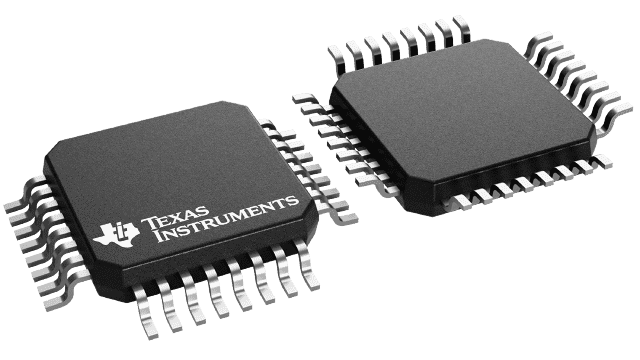Información de empaque
| Encapsulado | Pines TQFP (PBS) | 32 |
| Rango de temperatura de funcionamiento (℃) -50 to 125 |
| Cant. de paquetes | Empresa de transporte 250 | JEDEC TRAY (10+1) |
Características para ADS124S06
- Low Power Consumption: As Low as 280 µA
- Low-Noise PGA: 19 nVRMS at Gain = 128
- Programmable Gain: 1 to 128
- Programmable Data Rates: 2.5 SPS to 4 kSPS
- Simultaneous 50-Hz and 60-Hz Rejection at
≤ 20 SPS with Low-Latency Digital Filter - Analog Multiplexer with 12 (ADS124S08) or 6 (ADS124S06) Independently Selectable Inputs
- Dual-Matched Programmable Current Sources for Sensor Excitation: 10 µA to 2000 µA
- Internal Reference: 2.5 V, 10 ppm/°C (max) Drift
- Internal Oscillator: 4.096 MHz, 1.5% Accuracy
- Internal Temperature Sensor
- Extended Fault Detection Circuits
- Self Offset and System Calibration
- Four General-Purpose I/Os
- SPI-Compatible Interface with Optional CRC
- Analog Supply: Unipolar (2.7 V to 5.25 V) or Bipolar (±2.5 V)
- Digital Supply: 2.7 V to 3.6 V
- Operating Temperature: –50°C to +125°C
Descripción de ADS124S06
The ADS124S06 and ADS124S08 are precision, 24-bit, delta-sigma (ΔΣ), analog-to-digital converters (ADCs) that offer low power consumption and many integrated features to reduce system cost and component count in applications measuring small-signal sensors.
These ADCs feature configurable digital filters that offer low-latency conversion results
and 50-Hz or
60-Hz rejection for noisy industrial environments. A low-noise, programmable gain amplifier
(PGA) provides gains ranging from 1 to 128 to amplify low-level signals for resistive bridge or
thermocouple applications. Additionally, these devices integrate a low-drift, 2.5-V reference that
reduces printed circuit board (PCB) area. Finally, two programmable excitation current sources
(IDACs) allow for easy and accurate RTD biasing.
An input multiplexer supports 12 inputs for the ADS124S08 and six inputs for the ADS124S06 that can be connected to the ADC in any combination for design flexibility. In addition, these devices include features such as sensor burn-out detection, voltage bias for thermocouples, system monitoring, and four general-purpose I/Os.
The devices are offered in a leadless VQFN-32 or a TQFP-32 package.
